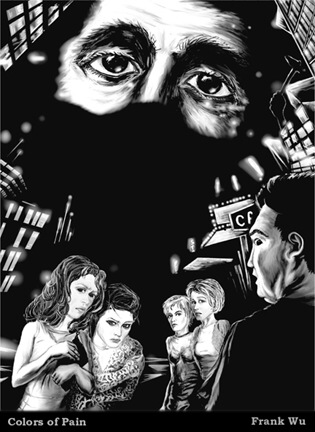
Illo for a story by Lyn Nichols and Ron Collins about a man recently and unhappily turned into a vampire. Published in the Australian print magazine Altair No. 5, p. 152. We see both his haggard expression and the frightened and wary looks on the faces of those he passes on the street.
The story takes place in Seattle, hence the small bit of Borofsky's Hammering Man statue in the upper right hand corner, pounding on the poor guy's head.
Ron Collins, who was a winner in the Writers of the Future contest in '99 (and a published finalist the year before) and is a well-published author now, has a homepage here. Follow the links in his Bibliography to his "Colors of Pain" page, where he describes how he and Lyn Nichols wrote this story.
Email to Frank Wu
Image (c) 2001 Frank Wu
Subject: In need of wisdom
Dear Mr Wu,
My reply:
Thanks, Chris, for your kind comments. And good luck on your exam.
I'm glad you liked "Colours of Pain." The initial idea for that piece comes from the story that it's illustrating, about a middle-aged, grizzly, worn-out guy who's a vampire, but not happy about that. So that's where the idea for the piece came, but the visual inspirations are something altogether different. The tone of the piece is partially inspired by "M", which is a classic 1931 Fritz Lang-directed movie. Really gritty, grainy, contrasty black and white. Peter Lorre's first movie - he plays this crazy child killer in Germany (all the dialog has this harsh, snappy German full of grunts and squawking and barking - as if they hired alligators who speak German instead of actors to be in the movie). Lorre is haunted by his own personal demons and inability to help himself, while meanwhile being hunted down by both the Berlin police and the Berlin underground (due to public outcry, the police have really brought the hammer down to search for the child killer, in the process cracking down on the Mob - and the Mob feels like if they catch the child killer, the police will let up on them). When Lorre is finally captured, he squeals like a pig. Astounding.
Another visual inspiration, particularly, for the eyes, is Albert
Einstein - there is a great picture of him as an old old man, hair all over
the place, and his eyes sad like a puppy. Why is the great man so sad?
Because his discoveries let indirectly to the construction of the most
devastating weapon ever created by man - something that could potentially
destroy the whole planet?
The girls are sort of inspired by all the cute girls in high school whom I
liked, but gave me dirty looks whenever I looked at them. The fashions
are inspired by various women's magazines.
Oh oh - another inspiration for this piece is another great early German movie, "The Cabinet of Dr. Caligari," a silent movie from 1919. It is about a crazy psychopath who may or may not be head of a psych ward, and he has in his control this sleep walker, the somnabulist Cesare, whom he sends off to do his killing. The design for the movie doesn't have a single right angle in it, and all the buildings are tilty and mangled - and that's a little of what I tried to get across with the landscape.
You also asked how I became an illustrator? It's really a lot of hard work. I look at lots of things, really study them. It all goes into my visual databank. You never know when an image you saw years or maybe decades ago will become important. For instance, in a story I'm illustrating right now, it mentions that the main aircraft is a ducted fan tilt-rotor. When I read that I remembered that I have a book about airplanes that I've had since, oh, 1976 or so when I was in sixth grade, and it has such an aircraft in it. Who knew way back then that his cool plane would come out in a drawing two and a half decades later? But my point is that, as a young artist, it's important to look at all sorts of different art, different artists, different movies, science books ("The Way Things Work" is just brilliant), books on architecture... It all comes out in the drawings eventually.
Anyway, I hope that helpful.
Frank